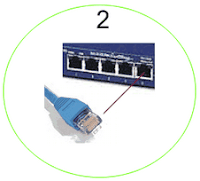1.1
Recognize the following logical or physical network topologies given a
schematic diagram or description:
> Ethernet Networks
In the diagram
below you will see two ethernet configurations. On the left the computers are
connected together with a single cable coming from the router/switch, this is
called a bus or thin ethernet configuration.
In bus
topologies, all computers are connected to a single cable or "trunk or
backbone", by a transceiver either directly or by using a short drop
cable. All ends of the cable must be terminated, that is plugged into a device
such as a computer or terminator. Most bus topologies use coax cables.
The number of
computers on a bus network will affect network performance, since only one
computer at a time can send data, the more computers you have on the network
the more computers there will be waiting send data. A line break at any point
along the trunk cable will result in total network failure.
Computers on a
bus only listen for data being sent they do not move data from one computer to
the next, this is called passive topology.
On the right
side of the diagram each computer connects directly to the router/switch. this
is how most ethernets are configured today. In this topology management of the
network is made much easier (such as adding and removing devices), because of
the central point. However because it is centralized more cable is required. If
one computer fails the network will continue to function.
If computers are
connected in a row, along a single cable this is called a bus topology, if they
branch out from a single junction or hub this is known as a star topology. When
computers are connected to a cable that forms a continuous loop this is called
a ring topology.




